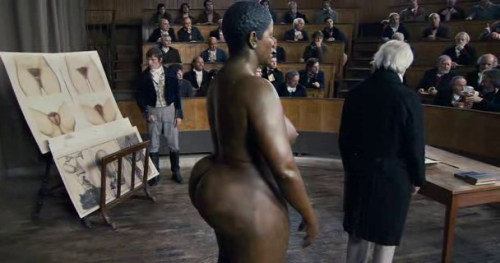


THE LIFE AND TIMES OF SARA BAARTMAN is the fascinating story of this Khoi Khoi woman who was taken from South Africa, and then exhibited as a freak across Britain. The image and idea of "The Hottentot Venus" swept through British popular culture. A court battle waged by abolitionists to free her from her exhibitors failed.
In 1814 she was taken to France, and became the object of scientific and medical research that formed the bedrock of European ideas about black female sexuality. She died the next year. But even after her death, Sara Baartman remained an object of imperialist scientific investigation. In the name of Science, her intimate organs and brain were displayed in the Musee de l'Homme in Paris until as recently as 1985.
Continue reading for Video:
Sarah “Saartjie” Baartman (before 1790 – 29 December 1815)[1] (also spelled Bartman, Bartmann, Baartmen) was the most famous of at least two[2] Khoikhoi women who were exhibited as freak show attractions in 19th-century Europe under the nameHottentot Venus—”Hottentot” as the then-current name for the Khoi people, now considered an offensive term,[3] and “Venus” in reference to the Roman goddess of love.
Southern Africa
The-life-and-times-of-sara-baartmanSarah Baartman was born to a Khoisan family in the vicinity of the Gamtoos River in what is now the Eastern Cape of South Africa.[3] She was orphaned in a commando raid. Saartjie, pronounced “Sahr-kee”, is the diminutive form of her name; inAfrikaans the use of the diminutive form commonly indicates familiarity, endearment or contempt. Her birth name is unknown.[4]
Baartman was a slave[3][5][6] of Dutch farmer named Peter Cezar near Cape Town, which had recently come under British control. Alexander Dunlop, a military surgeon with a sideline in supplying showmen in Britain with animal specimens, suggested she travel to England for exhibition.[7] Lord Caledon, governor of the Cape, gave permission for the trip, but later regretted it after he fully learned the purpose of the trip. She left for London in 1810.
Death and legacy
She died on 29 December 1815 of an undetermined[22] inflammatory ailment, possibly smallpox,[23][24] while other sources suggest she contracted syphilis,[3] or pneumonia. An autopsy was conducted, and published by French anatomist Henri Marie Ducrotay de Blainville in 1816 and republished by French naturalist Georges Cuvier in theMemoires du Museum d’Histoire Naturelle in 1817. Cuvier notes in his monograph that its subject was an intelligent woman with an excellent memory, particularly for faces. In addition to her native tongue she spoke fluent Dutch, passable English and a smattering of French. He describes her shoulders and back as “graceful”, arms “slender”, hands and feet as “charming” and “pretty”. He adds she was adept at playing the jew’s harp[25] could dance according to the traditions of her country and had a lively personality. Despite this he interpreted her remains, in accordance with his theories on racial evolution, as evidencing ape-like traits. He thought her small ears were similar to those of anorangutan and also compared her vivacity, when alive, to the quickness of a monkey.[13] Her skeleton, preserved genitals and brain were placed on display in Paris’ Musée de l’Homme[26] until 1974, when they were removed from public view and stored out of sight; a cast was still shown[27] for the following two years.
There were sporadic calls for the return of her remains, beginning in the 1940s, but the case became prominent only after Stephen Jay Gould wrote The Hottentot Venus in the 1980s. After the victory of the African National Congress in the South African general election, 1994, President Nelson Mandela formally requested that France return the remains. After much legal wrangling and debates in the French National Assembly, France acceded to the request on 6 March 2002. Her remains were repatriated to her homeland, the Gamtoos Valley, on 6 May 2002[18] and they were buried on 9 August 2002 on Vergaderingskop, a hill in the town ofHankey over 200 years after her birth.[28]
Baartman became an icon in South Africa as representative of many aspects of the nation’s history. The Saartjie Baartman Centre for Women and Children,[29] a refuge for survivors of domestic violence, opened in Cape Town in 1999. South Africa’s first offshore environmental protection vessel, the Sarah Baartman, is also named after her.[30]
Source: http://en.wikipedia.org/wiki/Sarah_Baartman
Share your thoughts....thanks!
Thank you for this history I will make sure all the youth in my life understand what others had to go through. My heart breaks as blacks are still treated to this day as objects to be poked at.
ReplyDeleteThanks for your concern! Thanks!
Delete